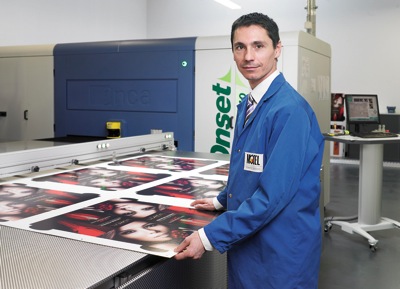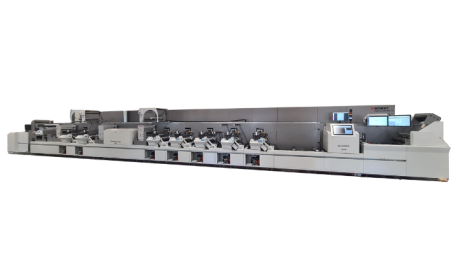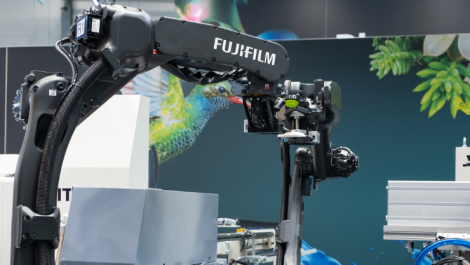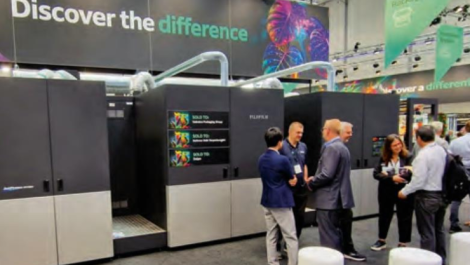Edoardo Finotti, head of the Model’s Innovation and Competence Centre, with the Inca Onset S40
Digital print on corrugated is a potential growth market for printers. With turnaround times of less than 48 hours, no minimum order and the ability to amend designs right up until final print, it offers the flexibility that is needed to win the race to get products on the shelves quickly without compromising on quality. By Neel Madsen.
Gone are the days where corrugated packaging was used simply as a method for transporting the goods from A to B. In today’s fast moving consumer goods market, corrugated forms part of the shop display and high quality retail ready packaging (RRP) is now a key demand from brand owners. If the corrugated packaging is going directly on the shelf then the print quality needs to be up to scratch.
For long runs, the increased quality in flexographic printing (in the form of high quality post print or HQPP) satisfies, but with the ever changing designs and much shorter runs, digital is now making inroads. The obvious advantage of printing corrugated digitally is the fast turnaround time, which means that the brand can have new designs on the shelf within days instead of weeks, enabling them to order smaller batches and react to trends in the market place instantly.
The increased number of SKUs is another driver as is the trend for personalisation. And by printing only what is needed, there are furthermore major cost savings to be had in terms of storage and waste. In terms of technology, there are a number of solutions on the market for printing corrugated digitally.
These are mainly flatbed wide formatprinters aimed at the POS market, but also with short run packaging in mind, including folding cartons and corrugated. Suppliers include HP Scitex, EFI, Durst, Screen, Inca, Agfa and Xanté amongst others. For finishing, there are Esko’s Kongsberg tables, Zund’s G3 digital cutter, Kase Make’s DYSS X7 digital die-cutting system and also Highcon’s Euclid digital cutting and creasing machine.
Print on demand
One company that has been pioneering on demand digital corrugated is Belmont Packaging, an established corrugated specialist which has now installed the UK’s first print on demand digital sheet plant. Using its experience and extensive knowledge of the corrugated industry gathered since its foundation in 1978, the Wigan-based company has now launched its ‘Print on Demand’ service giving customers full flexibility with regards to artwork and print runs.
Managing director, Sean Moloney, said, ‘Recent years of retail growth and sophistication have not only seen batch sizes reduced but also the need for quick turnaround of product to store. Our customers expect delivery within 48 hours of order and our abilities in efficient manufacturing coupled with vendor managed supply of stock means we are able to meet and exceed this demand.’
The company has invested heavily in digital technology and customers can order any run length from 50 to 10000 units in most cases without the need for additional tooling costs. One of the target markets was company start ups and small to medium companies. Mr Moloney explained, ‘We realised that these were being neglected in not being able to source small volume printed packaging, due to unwieldy unit prices and set up costs.
Using the latest technology in print and cutting, coupled with our existing machinery and design flow systems, we are able to provide a cost effective solution to any size of business.’ One of Belmont’s customers is Roosters Brewery in North Yorkshire, manufacturer of the Roosters Yankee brand and a supplier of ‘hop-forward’ cutting edge beers to outlets across the UK.
It has seen the benefits of small batch runs after ordering just 400 corrugated cases to launch three new bottled beers. Roosters managing director, Ian Fozard, commented, ‘Having the flexibility to order just a few hundred high quality, printed corrugated presentation boxes for our new range of fine beers is the ideal solution for getting the products to market more quickly, helping us to target individual sectors such as wholesalers and off-licences much more effectively.’
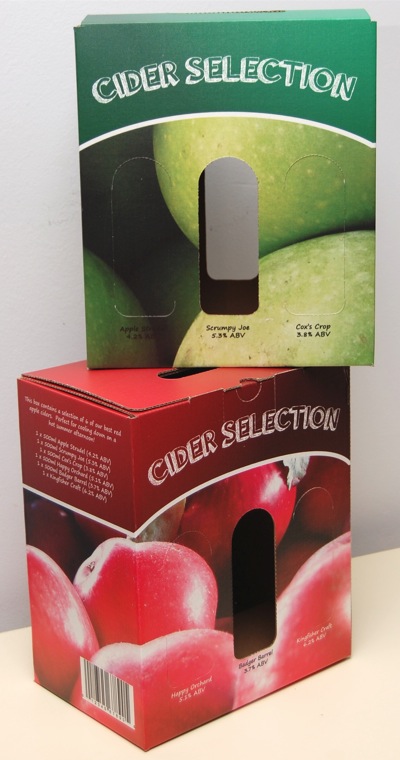 Example of digital corrugated from Belmont Packaging
Example of digital corrugated from Belmont Packaging
Model customer
A leading Swiss packaging manufacturer has also embraced production of digitally printed corrugated. It has done so through the investment in an Inca Onset S40 printer. Founded in 1882, Model Holding AG is the holding company of Model Group, a well established family owned business, which has its head office in Weinfelden, Switzerland, and over 16 subsidiaries and production sites spread across eight other countries in Europe.
The group has more than 3000 employees, 550 of which are based in Weinfelden. In 2011, it produced 619 million square metres of corrugated board, as well as 26,300 tonnes of cardboard packaging and 284,200 tonnes of container board.
The corporate HQ in Weinfelden is the flagship corrugated board plant. Historically, the group has printed offset and flexo. Offline and inline flexo machines are currently operating within the HQ, but 10 years ago, the company started to investigate digital print, recognising that it was an up-and-coming production method.
After initially outsourcing to a digital partner, in 2008, it installed its first entry level inkjet flatbed device to cut its teeth with this technology. Edoardo Finotti, head of the company’s Innovation and Competence Centre (ICC), explained, ‘In the last few years the importance of digital print has grown steadily.
There is an increasing demand for short run and personalised products, as well as strong pressure to reduce costs; digital print perfectly suits those requirements.’ Since 2008, the ICC has been monitoring the latest developments in digital printing in order to find the most productive, high quality and reliable technology to fulfil the high standards required by the packaging industry.
It says it has found the answer to these demands in the wide format flatbed Inca Onset S40 inkjet printer. ‘We were extremely impressed by the photographic-like images delivered by the Onset S40. What’s more, this print engine is a workhorse which guarantees extraordinary productivity and fits perfectly into our workflow,’ said Mr Finotti. He added, ‘This printer takes the flexibility typical of digital print to the highest level. It allows us to create limited and bespoke packs and displays with increased efficiency, as it doesn’t require set up times or prepress. It has helped us to diversify our production and has given us the opportunity to choose to go digital, whenever appropriate, depending on the job.’
The Inca Onset S40 prints at up to 470 square metres per hour, directly onto substrates up to 50 mm thick to create displays and packaging solutions. It has 168 user-replaceable printheads (28 per colour) on a full width print bar delivering a 27 picolitre drop size. These features, combined with its precision ink drop placement, produce 600 dpi print quality with the option of four or six colours. Following the purchase in May 2012, Model has built a dedicated digital department within its plant in Weinfelden.
Out of 20 operators working in print production, four have been allocated to the management of the new press on a three shift basis. In addition, it has also invested in a Zund G3 digital cutting plotter for finishing. Mr Finotti concluded, ‘We are committed to achieving a fully automated and end-to-end digital workflow.
We are focused on the fine tuning between print and finishing devices and currently we are using both the Zund digital cutting plotter and a traditional die-cutting machine to keep up with different production requirements.’
Finishing first
Glossop Cartons hit the headlines recently when it put in the order for the world’s first Highcon Euclid digital cutting and creasing machine. The company is due to take delivery of the machine in April. The Euclid combines patent-pending DART technology to create the digital crease lines, with a high speed and high quality laser cutting solution.
It does not require a conventional die, removing the time and costs associated with die production and additional machine set up. This enables greater versatility and flexibility to respond to customer needs, meet tighter deadlines and deliver short and medium run length jobs profitability.
Mark Nixon of Conversion, Highcon’s channel partner in the UK, who closed the deal with Glossop Cartons said, ‘Glossop Cartons is an ideal candidate for the Highcon Euclid. It specialises in offering customers flexibility and service and the digital cutting and creasing capabilities of the machine will allow it to enhance its product offering and bring quality packages to the shelf even more rapidly.’
At the Packaging Innovations show in Birmingham, director Jacky Sidebottom took part in Highcon’s learnShop seminar in the Print Innovations zone. Here she revealed that the next step for the company will be to complement the finishing machine with a new digital press. It remains to be seen which piece of kit the company will choose in its quest to stay on the forefront of developments in corrugated packaging.

